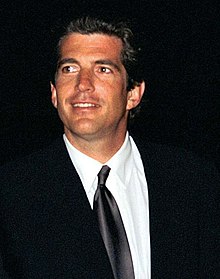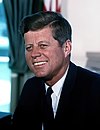John F. Kennedy Jr.
John Fitzgerald Kennedy, Jr. | |
|---|---|
 John F. Kennedy Jr. greets invited guests at the HBO and Imagine Entertainment premiere held at Kennedy Space Center | |
| Born | John Fitzgerald Kennedy, Jr. November 25, 1960 |
| Died | July 16, 1999 (aged 38) Atlantic Ocean, off the coast of Martha's Vineyard |
| Occupation(s) | lawyer and journalist |
| Spouse | Carolyn Jeanne Bessette (1996–1999) |
| Children | none |
| Parent(s) | John F. Kennedy (May 29, 1917–November 22, 1963) Jacqueline Kennedy Onassis (July 28, 1929–May 19, 1994) |

File:/Users/bkn/Desktop/448a09841c1c3 s.jpg Template:FixHTML
Template:FixHTML John Fitzgerald Kennedy, Jr. (November 25, 1960 – July 16, 1999), often referred to as John F. Kennedy, Jr., JFK Jr., John Jr., John Kennedy or John-John, was a pilot, lawyer, journalist, and socialite. He was the third child and first son of President John F. Kennedy and Jacqueline Kennedy, the nephew of Ted Kennedy and the deceased Robert F. Kennedy, and the younger brother of Caroline Kennedy and the older brother of the deceased Patrick Bouvier Kennedy. He was known as "America's Son" for he was one of the few presidential children to actually be raised in the White House. He died in a plane crash along with his wife and sister-in-law at the age of 38.
Early life
Born at Georgetown University Hospital sixteen days after his father was elected to the presidency, John F. Kennedy, Jr., was in the public spotlight from infancy until his death in 1999. He lived for most of the first three years of his life in the White House, and in the eye of the media and public who adored his antics. The nickname "John-John" came from a reporter mishearing JFK calling him ("John" spoken twice in quick succession). Even as a boy, he was often photographed and still referred to publicly as "John-John", although Kennedy family members themselves did not use the nickname. [1] They found it rather annoying, as did he. When he got to go to school, he got in a fight on his first day when a classmate insisted on calling him John-John.
His father was assassinated on November 22, 1963, and the funeral procession took place on his third birthday three days later. In a moment that became an emotional and iconic image of the 1960s, young JFK, Jr. stepped forward and rendered a final salute as the flag-draped casket was carried out from St. Matthew's Cathedral.[2] Following his father's assassination, he grew up on the Upper East Side of Manhattan in New York City, and his mother re-married in 1968 to Greek shipping tycoon Aristotle Onassis, whom she met in the early 1960s while still married to John F. Kennedy, and the marriage lasted for eight years until Onassis' death in 1975, when John was fourteen years old.
Education
He attended the Collegiate School in New York City for the third through tenth grades, and later graduated from the Phillips Academy. Forgoing his family legacy of attending Harvard University, Kennedy opted to attend another Ivy League, and graduated from Brown University in 1983 with a bachelor's degree in History. While at Brown, Kennedy was a member of the Phi Kappa Psi fraternity. In 1989, he earned a J.D. degree from the New York University School of Law. He failed the New York bar exam twice before passing on the third try. Special accommodations were arranged for him on his third try, wherein he took the examination alone (as the sole examinee) in a private room, accompanied by a proctor.
Career
He spoke at the 1988 Democratic National Convention in Atlanta. He was an assistant district attorney in Manhattan from 1989 to 1993. In 1995, he founded George, a glossy politics-as-lifestyle monthly which sometimes took editorial aim even at members of his own family. After Kennedy's death, the magazine was bought out by Hachette Filipacchi Magazines[3] and continued for over a year. With falling advertising sales,[3] the magazine folded in early 2001.[4]
Marriage
Through the 1980s until his death, Kennedy was an often-seen and much-photographed personality in Manhattan. He dated Madonna, and later married Carolyn Jeanne Bessette on September 21, 1996 on Cumberland Island in Georgia. His sister Caroline acted as the maid of honor and his cousin Anthony Stanislas Radziwill acted as best man.
Death
On July 16, 1999, at the age of 38, Kennedy was killed along with his wife and his sister-in-law Lauren Bessette when the aircraft he was piloting crashed into the Atlantic Ocean. He was piloting a Piper Saratoga II HP from Essex County Airport in New Jersey to Martha's Vineyard. He and his wife were traveling to the wedding of his cousin Rory Kennedy in Hyannis, Massachusetts, which was then postponed. Lauren was to have been dropped off at Martha's Vineyard en route.
Kennedy's aircraft impacted the water inverted and at a high rate of speed, a result typical of spatial disorientation and loss of control. Although the visibility at the time and location of the incident might have been above the minimums required for flight under visual flight rules (the only type of operation Kennedy was certified for), inexperienced pilots do sometimes experience spatial disorientation over water at night.
If a pilot becomes spatially disoriented and fails to control the aircraft properly by instruments, the airplane can enter a diving spiral from which recovery is difficult. If the spiral is not corrected, the airplane may break apart in the air or strike the surface at high speed. This type of mishap has been called the "graveyard spiral," a term reflecting the serioiusness of spatial disorientation and loss of control.
Aircraft such as the Saratoga II can however be controlled with reference to instruments in reduced visibility or night overwater operation. To obtain their initial Private Pilot certification, pilots must demonstrate basic skills in aircraft control by instruments. However, operation in meterological conditions where visual flight rules do not apply is restricted to pilots with a further, instrument certification. At the time of the mishap, Kennedy was working on, but had not completed, this certification.
In addition, Kennedy's aircraft was equipped with an autopilot that could have maintained control and prevented a spiral dive. Radar tracking data indicate that he most likely used the autopilot during the majority of his flight. The NTSB determined that the autopilot was not on at the time of the crash. There is no requirement to operate an autopilot during flight, and all pilots must demonstrate competence in contolling the aircraft without use of an autopilot.
He was very familiar with the route flown that evening. He had flown it over 35 times, often at night, and had landed several times at Martha's Vineyard Airport during IFR (instrument flight rules) conditions. More than half of these trips were flown without a CFI (certified flight instructor) aboard. However, during the two months prior to the crash, he almost always flew with a CFI aboard. There were two reasons for this. First, he had injured his ankle and needed assistance with the rudder pedals, with which use is vital during takeoff and landing. Second, he was working on an instrument rating and needed flight hours during IFR conditions, which requires an instructor aboard.
While pilots gave conflicting versions of the meteorological conditions en route, the tower ATC manager at Martha's Vineyard stated that "The visibility, present weather, and sky condition at the approximate time of the accident was probably a little better than what was being reported. I say this because I remember aircraft on visual approaches saying they had the airport in sight between 10 and 12 miles out. I do recall being able to see those aircraft and I do remember seeing the stars out that night."
Memorial tributes and services
During the memorial service on July 23, 1999, Kennedy's uncle, Massachusetts Democratic Senator Ted Kennedy, stated, "We dared to think that this John Kennedy would live to comb gray hair, with his beloved Carolyn by his side. But, like his father, he had every gift but length of years." And of his nephew's marriage, he invoked what had been said of his brother's Presidency: both lasted 1,000 days. Then-U.S. President Bill Clinton attended the service and ordered that the flag at the White House be lowered to half-staff in honor of John F. Kennedy, Jr.
At President Clinton's orders, warships of the United States Navy assisted in the search for the downed plane. With the permission of Secretary of Defense William Cohen, a memorial service for the three victims was held aboard the Navy ship USS Briscoe. The cremated remains of Kennedy, his wife and sister-in-law were then scattered from the ship off the coast of Martha's Vineyard.
Wrongful-death lawsuit
A wrongful death lawsuit brought by the Bessette family against the Kennedy estate concluded with an undisclosed out of court settlement.[5] The settlement avoided the publicity of a public trial, as the accident facts pointed to pilot error.
References
- ^ Kennedy, Year in Review, CNN.
- ^ Lucas, Dean (2007-07-22). "Famous Pictures Magazine - JFK jr salutes JFK" (HTML). Famous Pictures Magazine. Retrieved 2007-07-21.
- ^ a b Bercovici, Jeff. Hachette delivers death ax to George. Media Life Magazine. 2001.
- ^ CNN Transcript: Reliable Sources: 'George' Folds. January 6, 2001.
- ^ "Biography of Carolyn Bessette".
See also
- Kennedy Curse
- Kennedy family
- John F. Kennedy assassination
- Robert F. Kennedy assassination
- Sensory illusions in aviation
- Spatial disorientation
- Bárány chair
- The Day the Music Died, and Roger Peterson (pilot)
- Flash Airlines Flight 604
- Air India Flight 855
External links
- John F. Kennedy Jr. at IMDb
- National Transportation Safety Board investigation final report
- Web of conspiracy surrounds JFK Jr.'s death
- JFK Jr's political donations
- CNN.com In-depth coverage of JFK Jr's death
- Kennedy's body, airplane wreckage found
- John F. Kennedy, Jr. at the Notable Names Database
- Regarding JFK Jr.'s burial at sea
- JFK II & The Assassination of JFK, Jr.
- If William Shakespear was still alive, we all know what he would call this tragedy: Unfortunate Son
{{subst:#if:Kennedy, John F., Jr.|}} [[Category:{{subst:#switch:{{subst:uc:1960}}
|| UNKNOWN | MISSING = Year of birth missing {{subst:#switch:{{subst:uc:1999}}||LIVING=(living people)}}
| #default = 1960 births
}}]] {{subst:#switch:{{subst:uc:1999}}
|| LIVING = | MISSING = | UNKNOWN = | #default =
}}
- Living people
- 1999 deaths
- Accidental human deaths in Massachusetts
- American aviators
- American businesspeople
- American magazine publishers (people)
- American Roman Catholics
- American socialites
- Aviators killed in aviation accidents or incidents in the United States
- Bouvier family
- Brown University alumni
- Children of Presidents of the United States
- English Americans
- French Americans
- Irish-Americans
- Irish-American writers
- John F. Kennedy
- Kennedy family
- New York lawyers
- New York University School of Law alumni
- People from Manhattan
- People from Washington, D.C.
- Phillips Academy alumni
- Scottish-Americans
- The Collegiate School alumni



